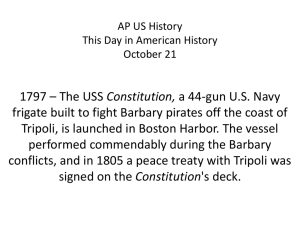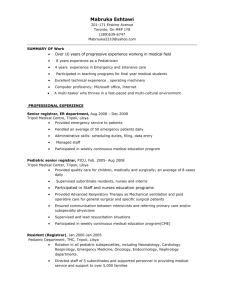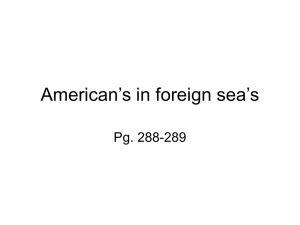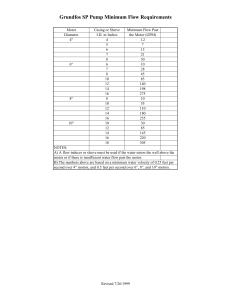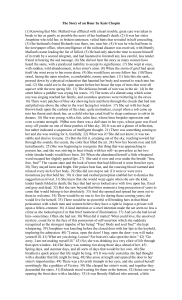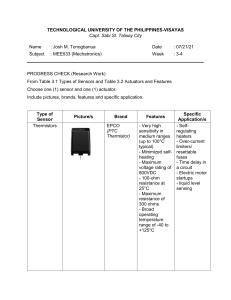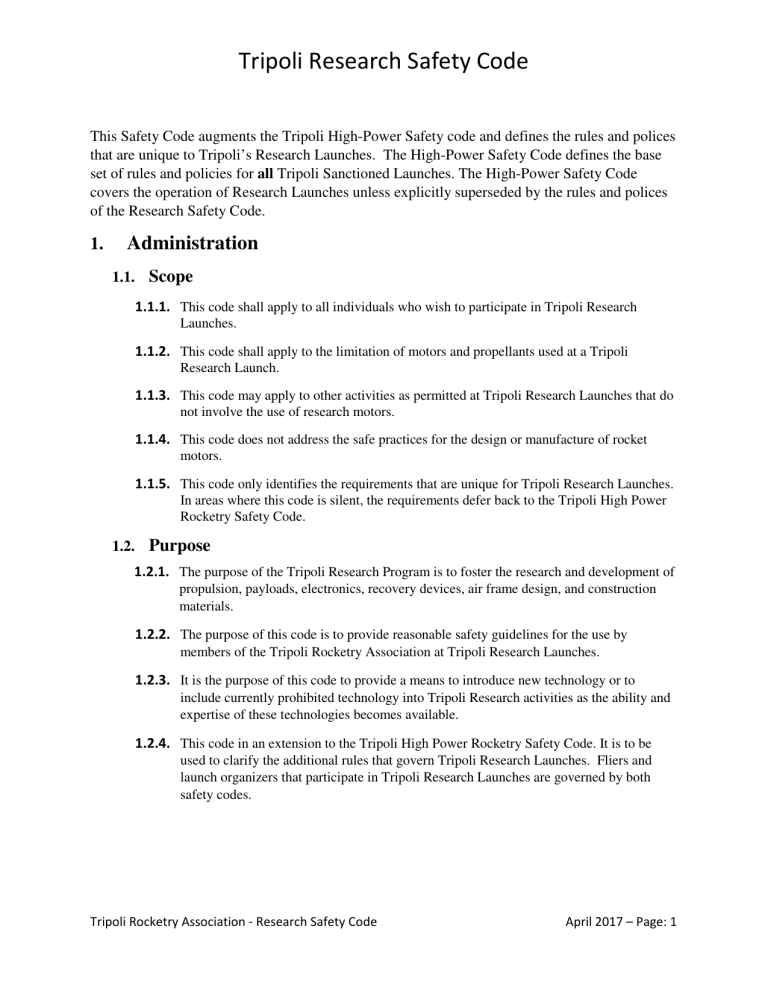
Tripoli Research Safety Code This Safety Code augments the Tripoli High-Power Safety code and defines the rules and polices that are unique to Tripoli’s Research Launches. The High-Power Safety Code defines the base set of rules and policies for all Tripoli Sanctioned Launches. The High-Power Safety Code covers the operation of Research Launches unless explicitly superseded by the rules and polices of the Research Safety Code. 1. Administration 1.1. Scope 1.1.1. This code shall apply to all individuals who wish to participate in Tripoli Research Launches. 1.1.2. This code shall apply to the limitation of motors and propellants used at a Tripoli Research Launch. 1.1.3. This code may apply to other activities as permitted at Tripoli Research Launches that do not involve the use of research motors. 1.1.4. This code does not address the safe practices for the design or manufacture of rocket motors. 1.1.5. This code only identifies the requirements that are unique for Tripoli Research Launches. In areas where this code is silent, the requirements defer back to the Tripoli High Power Rocketry Safety Code. 1.2. Purpose 1.2.1. The purpose of the Tripoli Research Program is to foster the research and development of propulsion, payloads, electronics, recovery devices, air frame design, and construction materials. 1.2.2. The purpose of this code is to provide reasonable safety guidelines for the use by members of the Tripoli Rocketry Association at Tripoli Research Launches. 1.2.3. It is the purpose of this code to provide a means to introduce new technology or to include currently prohibited technology into Tripoli Research activities as the ability and expertise of these technologies becomes available. 1.2.4. This code in an extension to the Tripoli High Power Rocketry Safety Code. It is to be used to clarify the additional rules that govern Tripoli Research Launches. Fliers and launch organizers that participate in Tripoli Research Launches are governed by both safety codes. Tripoli Rocketry Association - Research Safety Code April 2017 – Page: 1 Tripoli Research Safety Code 2. Referenced Publications 2.1. General 2.1.1. Some of the documents or portions thereof listed in this chapter are referenced within this code and shall be considered part of the requirements of this document except for such requirements modified or waived in this code. 2.1.2. TRA Publications. Tripoli Rocketry Association, Inc., P. O. Box 87, Bellevue NE 68005. Articles of Incorporation and Bylaws High Power Rocketry Safety Code Tripoli Motor Testing Committee (TMT), Testing Policies 2.1.3. NFPS Publications. National Fire Protection Association, 1 Batterymarch Park, P.O. Box 9101, Quincy MA 02269-9101. NFPA 1122, Code for Model Rocketry NFPA 1127, Code for High Power Rocketry 3. Definitions 3.1. General 3.1.1. The definitions contained in this chapter shall apply to the terms used in this code. Where terms are not included, common usage of the terms shall apply. 3.2. Tripoli Research Definitions 3.2.1. BoD. Board of Directors of the Tripoli Rocketry Association, Inc. 3.2.2. Rocket Motor. As used in this code, Rocket Motor shall refer only to Composite Propellant, Sugar Propellant, commercial black powder, and Hybrid Rocket Motor. 3.2.2.1. Certified Motor. Any commercial motor which has been certified by Tripoli Motor Testing (TMT), NAR Standards and Testing (S&T), or CAR Motor Certification Committee. 3.2.2.2. Expired Motor. Any previously certified motor, for which its certification has expired. 3.2.2.3. Decertified Motor. These motors have been decertified by the Tripoli Motor Testing (TMT), NAR Standards and Testing (S&T), or CAR Motor Certification Committee. These motors may NOT be used. 3.2.2.4. Research Motor. Any motor made for personal use which is not a Certified Motor. Research motors shall not be sold or distributed for a profit. 3.2.2.5. Commercial Motor Approved for Research Use Only. Any commercial motor that has been reviewed and approved by Tripoli Motor Testing (TMT) that exceeds the total thrust limit identified in NFPA 1127. Tripoli Rocketry Association - Research Safety Code April 2017 – Page: 2 Tripoli Research Safety Code 3.2.2.6. Composite Propellant Rocket Motor Any device defined as a Rocket Motor that utilizes a propellant charge consisting primarily of an inorganic oxidizer dispersed in a carbonaceous polymeric binder. 3.2.2.7. Hybrid Rocket Motor. A rocket motor in which the fuel exists in a different physical state (solid or gaseous) than the oxidizer and that derives its force or thrust from the combination thereof. 3.2.2.8. Sugar Propellant Motor. A propellant charge containing potassium nitrate as the primary oxidizer, and containing either dextrose or sorbitol or erythritol as the primary fuel and binder. 3.2.3. Range Safety Officer (RSO). A Tripoli Level 2 or Level 3 member who is responsible for the safety of the launch. 3.2.4. Launch Director (LD). A Tripoli Level 2 or Level 3 member who has overall administrative responsibility for the launch. 3.2.5. NAR. The National Association of Rocketry. 3.2.6. Tripoli High Power Launch. Any Tripoli launch where only certified motors may be flown. 3.2.7. Shall. Indicates a mandatory requirement. 3.2.8. Tripoli (TRA). Tripoli Rocketry Association, Inc. 3.2.9. TRC Tripoli Research Committee 3.2.10. Tripoli Research Launch. Any Tripoli Research launch where research activities, as described in this code, may be conducted. 4. Limits of Liability 4.1. Disclaimer 4.1.1. The Tripoli Rocketry Association does not in any way participate in the manufacturing or fabrication process of Research Rocket Motors or propellants. 4.1.2. The Tripoli Rocketry Association does not regulate, approve, or officially support or endorse any propellant manufacturing or fabrication process, or in any way imply such approval. 4.1.3. The Tripoli Rocketry Association does not endorse or provide any safety codes for the self- manufacture of any propellant. 4.1.4. The publishing or reporting of any research rocketry activity in any publication shall not imply TRA endorsement of any research activity or endorsement of any research manufacturing or fabrication procedure. Tripoli Rocketry Association - Research Safety Code April 2017 – Page: 3 Tripoli Research Safety Code 5. Exclusions 5.1. Black Powder Rocket Motors 5.1.1. Black powder-based research motors are prohibited (including as a composite ingredient, regardless of binder and/or formulation modifications). Certified black powder motors are not excluded by this code. 5.2. Liquid Rocket Motors 5.2.1. With the exception of nitrous-oxide hybrid rocket motors, liquid rocket motors are generally prohibited at Tripoli Research Launches. BOD approval may be given for very well documented liquid motor projects. All such projects must be submitted to the TRC for review and recommendation to the BOD. 5.3. Additional Prohibited Propellants 5.3.1. The following propellants shall also be excluded from Tripoli Research launches: doublebased, triple-based, and micro-grain propellants (including zinc/sulfur propellants). 6. Process of Inclusion 6.1. General 6.1.1. A proposal for the introduction of new technologies and the inclusion of currently prohibited technologies into the Tripoli Research program shall be submitted, in writing, to the TRC for review and recommendation to the BOD. 6.1.2. The originator(s) of the proposal shall provide any and all technical documents that may be requested by the TRC and/or the BOD. 6.1.3. Following review, the TRC and BOD may set a time and location for a demonstration of the requested technology, as is deemed necessary by the TRC and BOD. 6.1.4. After demonstration and testing, the TRC and BOD shall determine whether or not to introduce the requested technology into the Tripoli Research program. 6.1.5. Acceptance of new technology shall be based on technical data, and/or on review of any federal regulations that may impact the association or the hobby with the inclusion of any new technology, and/or on the impact of said technology on TRA insurance coverage. 6.1.6. If the requested technology is introduced, the TRC shall recommend any necessary changes to this code to safely introduce said technology for Tripoli Research use. 6.1.7. Any new technology approved shall be used in accordance with this code and any future requirements that may be added to this code. Tripoli Rocketry Association - Research Safety Code April 2017 – Page: 4 Tripoli Research Safety Code 7. Tripoli Research Launches 7.1. Tripoli Launch Operations 7.1.1. All flights and static tests that use research motors shall be conducted by Tripoli members who are Tripoli certified level 2 or higher. 7.1.2. A person who makes the research motor(s) for a Tripoli Research group project may do so only if they are a member of said group, and may collect only the costs (without profit) for materials used to produce the motor(s) for use in the group project. 7.2. Prohibitions 7.2.1. Research motors shall not be used for certification flights. 7.2.2. Research motors shall not be fabricated of steel or other frangible materials (e.g. PVC). 7.2.2.1. Cases (including hybrid cylinders), front and rear closures, and nozzles shall not be fabricated of steel. 7.2.2.2. Screws, washers, compression rings and related closures, and sealing devices shall be exempt from requirement 7.2.2.1. 7.3. Distances 7.3.1. The maximum launch altitude for flights containing research motors shall be 90% of the authorized altitude established for the launch. 7.3.2. The minimum safe standoff distance from the spectator and Model Rocket Launch Area for any research / high power flight and / or static test shall be per the distance table below. 7.4. Approved Motors 7.4.1. Research Motors, Certified Motors, Expired Certified Motors and Commercial Motors Approved for Research Use Only shall be allowed at a Tripoli Research Launches. 7.4.2. Members of NAR who are not members of TRA shall be limited to the use of Certified Motors only. 7.4.3. Rockets containing a total impulse of more than 40,960 N-s shall not be flown without prior review/approval of the Tripoli Class 3 committee. 8. Waived Rules and Exceptions 8.1. Application for Waiver or Exceptions 8.1.1. Any provision of this code waived or excluded by the BOD shall be on a case-by-case basis. Tripoli Rocketry Association - Research Safety Code April 2017 – Page: 5 Tripoli Research Safety Code 8.1.2. Application for exceptions to any provision of this code shall be submitted in writing to the BOD at least 30 days prior to the activity covered by the exception. 8.1.3. In the event that BOD approval for waiver or exclusion from any provision of this code is granted, said approval shall apply only to a single event, at a single location. Research / High Power Launch Area Safe Standoff Distances Total Installed Impulse, N-s Motor type Non-Complex Complex feet meters feet meters 0.01 to 1,280 A-J 200 61 250 76 1,280.01 to 2,560 K 250 76 350 107 2,560.01 to 5,120 L 300 92 500 153 5,120.01 to 10,240 M 500 153 1,000 305 10,240.01 to 20,480 N 1,000 305 1,500 457 20,480.01 to 40,960 O 1,500 457 2,000 610 40,960.01 to 890,000 P-T 2,000 610 2,500 762 Tripoli Rocketry Association - Research Safety Code April 2017 – Page: 6
